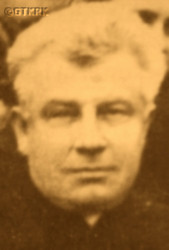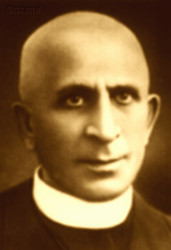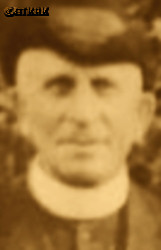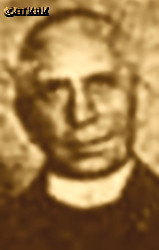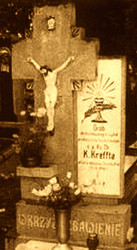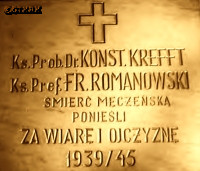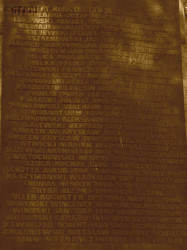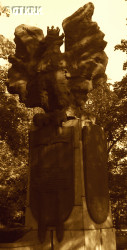Roman Catholic
St Sigismund parish
05-507 Słomczyn
85 Wiślana Str.
Konstancin deanery
Warsaw archdiocese, Poland
full list:
displayClick to display full list

searchClick to search full list by categories
wyświetlKliknij by wyświetlić pełną listę po polsku

szukajKliknij by przeszukać listę wg kategorii po polsku

Martyrology of the clergy — Poland
XX century (1914 – 1989)
personal data
religious status
Servant of God
surname
KREFFT
forename(s)
Constantine Francis (pl. Konstantyn Franciszek)
function
diocesan priest
creed
Latin (Roman Catholic) Church RCmore on
en.wikipedia.org
[access: 2014.09.21]
diocese / province
Culm (Chełmno) diocesemore on
pl.wikipedia.org
[access: 2012.11.23]
academic distinctions
Doctor of Sacred Theology
honorary titles
Ad Honores Spiritual Counselor
(c. 1930)
„Medal of Independence”more on
en.wikipedia.org
[access: 2019.02.02]
(27.06.1938)
date and place
of death
11.06.1940

KL Stutthofconcentration camp
today: Sztutowo, Sztutowo gm., Nowy Dwór Gdański pov., Pomerania voiv., Poland
more on
en.wikipedia.org
[access: 2022.01.09]
details of death
In 1885‐1888 while studying at Germ. Königliches Katholisches Gymnasium (Eng. Royal Catholic Gymnasium) in Chojnice — during Prussian times (partitions of Poland) — member of the gymnasium chapter of a clandestine Polish self–education Pomeranian Philomaths organisation.
During the Polish–Russian war of 1919‐1921, during the Russian offensive in 1920, representative of the Citizens' Executive Committee of the State Defense Council in Zblewo led by Gen. Joseph Haller. Organized a recruitment point for the Volunteer Army and led a campaign to collect contributions and provide soldiers with supplies. The action led to the formation of the two Kashubian battalions, which, as part of the artillery, cavalry and auxiliary units, took part in military operations, contributing to the Russian defeat in the Battle of Warsaw on 15.08.1920 („Miracle on the Vistula”).
After German and Russian invasion of Poland in 09.1939 and start of the World War II, after start of German occupation, arrested by the Germans on 28.10.1939 (on 30.09.1939 according to other sources), beaten up.
Jailed in VSH Kamin custody in Kamień Pomorski.
From there on 15.12.1939 transported to KL Stutthof concentration camp where perished.
prisoner camp's numbers
8475Click to display source page (KL StutthofClick to display the description)
cause of death
extermination: exhaustion and starvation
perpetrators
Germans
sites and events
KL StutthofClick to display the description, VSH KaminClick to display the description, «Intelligenzaktion»Click to display the description, Reichsgau Danzig‐WestpreußenClick to display the description, Ribbentrop‐MolotovClick to display the description, Pius XI's encyclicalsClick to display the description, Polish‐Russian war of 1919‐1921Click to display the description, Pomeranian PhilomathsClick to display the description
date and place
of birth
07.03.1867

Lubniatoday: Brusy gm., Chojnice pov., Pomerania voiv., Poland
more on
en.wikipedia.org
[access: 2022.01.28]
parents
KREFFT John
🞲 26.06.1823, Kłodnotoday: Sulęczyno gm., Kartuzy pov., Pomerania voiv., Poland
more on
en.wikipedia.org
[access: 2025.08.19] — 🕆 28.04.1897, Kosobudytoday: Brusy gm., Chojnice pov., Pomerania voiv., Poland
more on
en.wikipedia.org
[access: 2022.01.28]

SZCZEPAŃSKA Elisabeth
🞲 19.11.1829, Lubniatoday: Brusy gm., Chojnice pov., Pomerania voiv., Poland
more on
en.wikipedia.org
[access: 2022.01.28] — 🕆 07.04.1888, Kosobudytoday: Brusy gm., Chojnice pov., Pomerania voiv., Poland
more on
en.wikipedia.org
[access: 2022.01.28]
presbyter (holy orders)
ordination
12.09.1893

Pelplintoday: Pelplin gm., Tczew pov., Pomerania voiv., Poland
more on
en.wikipedia.org
[access: 2021.05.06]
positions held
1931 – 1939
parish priest — Tucholatoday: Tuchola gm., Tuchola pov., Kuyavia‐Pomerania voiv., Poland
more on
en.wikipedia.org
[access: 2021.09.02] ⋄ St Bartholomew the Apostle RC parish (main parish) ⋄ Tucholatoday: Tuchola gm., Tuchola pov., Kuyavia‐Pomerania voiv., Poland
more on
en.wikipedia.org
[access: 2021.09.02] RC deanery — also: Corpus Christi church builder, pro‐synodal examiner (c. 1930‐1939), inspector of religious education in elementary schools in the deanery, censor of religious publications (c. 1929‐1938)
1927 – 1931
parish priest — Subkowytoday: Subkowy gm., Tczew pov., Pomerania voiv., Poland
more on
en.wikipedia.org
[access: 2021.09.02] ⋄ St Stanislav the Bishop and Martyr RC parish ⋄ Tczewtoday: Tczew urban gm., Tczew pov., Pomerania voiv., Poland
more on
en.wikipedia.org
[access: 2021.09.02] RC deanery
1904 – 1927
parish priest — Zblewotoday: Zblewo gm., Starogard Gdański pov., Pomerania voiv., Poland
more on
en.wikipedia.org
[access: 2021.09.02] ⋄ St Michael the Archangel RC parish ⋄ Starogard Gdańskitoday: Starogard Gdański gm., Starogard Gdański pov., Pomerania voiv., Poland
more on
en.wikipedia.org
[access: 2021.06.07] RC deanery — also: builder of the fillial church in Piece; 1905 founder and chairman of the Cooperative Bank in Zblewo
1901 – 1904
curatus/rector/expositus — Sopottoday: Sopot city pov., Pomerania voiv., Poland
more on
en.wikipedia.org
[access: 2022.01.28] ⋄ Blessed Virgin Mary of the Assumption – Star of the Sea RC church ⋄ Oliwatoday: district in Gdańsk, Gdańsk city pov., Pomerania voiv., Poland
more on
en.wikipedia.org
[access: 2022.07.16], Holy Trinity RC parish ⋄ Gdańsk Ideanery name
today: Gdańsk city pov., Pomerania voiv., Poland
more on
en.wikipedia.org
[access: 2021.07.04] RC deanery — also: church builder
1899 – 1901
administrator — Bytówtoday: Bytów gm., Bytów pov., Pomerania voiv., Poland
more on
en.wikipedia.org
[access: 2022.06.29] ⋄ St Catherine of Alexandria the Virgin and Martyr RC parish
vicar — GdańskŚródmieście district
today: Gdańsk city pov., Pomerania voiv., Poland
more on
en.wikipedia.org
[access: 2022.02.24] ⋄ St Brigitte RC church ⋄ St Nicholas the Bishop and Confessor RC parish
till 1895
PhD student — Freiburg im Breisgautoday: Freiburg im Breisgau urban dist., Freiburg reg., Baden‐Württemberg state, Germany
more on
en.wikipedia.org
[access: 2020.07.31] ⋄ theology, Albrecht and Louis University — PhD thesis Germ. „Die Gotteslehre Justins des Märtyrers” (Eng. „The Theology of Justin the Martyr”), public defense on 23.02.1895
c. 1893
vicar — Grudziądztoday: Grudziądz city pov., Kuyavia‐Pomerania voiv., Poland
more on
en.wikipedia.org
[access: 2021.09.02] ⋄ St Nicholas the Bishop and Confessor RC parish (main parish) ⋄ Łasintoday: Łasin gm., Grudziądz pov., Kuyavia‐Pomerania voiv., Poland
more on
en.wikipedia.org
[access: 2021.09.02] RC deanery
1888 – 1893
student — Pelplintoday: Pelplin gm., Tczew pov., Pomerania voiv., Poland
more on
en.wikipedia.org
[access: 2021.05.06] ⋄ philosophy and theology, Theological Seminary
1900 – 1939
membership — Toruńtoday: Toruń city pov., Kuyavia‐Pomerania voiv., Poland
more on
en.wikipedia.org
[access: 2021.06.20] ⋄ scientific society
others related
in death
ROMANOWSKIClick to display biography Francis, BOLTClick to display biography Felix, BORKOWSKIClick to display biography Paul, BRUDNICKIClick to display biography Alexander Casimir, BRZEZIŃSKIClick to display biography Paul John, CZAPLEWSKIClick to display biography John Bruno, DOMACHOWSKIClick to display biography Joseph, FARULEWSKIClick to display biography Thaddeus, GÓRECKIClick to display biography Marian, GRABOWSKI–WIDŁAKClick to display biography Casimir, GUMPERTClick to display biography Steven Edward, KALINOWSKIClick to display biography Anthony, KARBAUMClick to display biography Ernest, KOMOROWSKIClick to display biography Bronislav Boleslav, KUBICKIClick to display biography Telesphorus, LESIŃSKIClick to display biography Alexander, LESIŃSKIClick to display biography John, ŁĘGOWSKIClick to display biography Vladislav Leonard, MALINOWSKIClick to display biography Thaddeus, MAŁKOWSKIClick to display biography Julius, MAŃKOWSKIClick to display biography Alphonse, MATERNICKIClick to display biography Vladislav, MAZELLAClick to display biography John, NIEMIRClick to display biography Joseph, OSSOWSKIClick to display biography Valerian, POŁOMSKIClick to display biography Leo Louis John, RODZIŃSKAClick to display biography Stanislava (Sr Mary Julia), ROGACZEWSKIClick to display biography Francis Xavier, RÓŻYCKIClick to display biography Mieczyslav Bogumil, RYGLEWICZClick to display biography John, SĄDECKIClick to display biography Bernard, SARNOWSKIClick to display biography Joseph, SCHULZClick to display biography Alphonse Vaclav, SEPEŁOWSKIClick to display biography Vaclav, SMOLEŃSKIClick to display biography Bronislav, SROKAClick to display biography Leo Florian, SZWEDOWSKIClick to display biography Ignatius Mieczyslav, SZYMAŃSKIClick to display biography John Joseph, SZYMAŃSKIClick to display biography Vladislav, WIECKIClick to display biography Bernard Anthony, WILMOWSKIClick to display biography John
sites and events
descriptions
KL Stutthof: In German Germ. Konzentrationslager (Eng. concentration camp) KL Stutthof (then in Eastern Prussian belonging to Germany, today: Sztutowo village) concentration camp, that Germans started to build on 02.09.1939, a day after German invasion of Poland and start of the World War II, Germans held c. 110,000‐127,000 prisoners from 28 countries, including 49,000 women and children. C. 65,000 victims were murdered and exterminated. In the period of 25.01‐27.04.1945 in the face of approaching Russian army Germans evacuated the camp. When on 09.05.1945 Russians soldiers entered the camp only 100 prisoners were still there. In an initial period (1939‐1940) Polish Catholic priests from Pomerania were held captive there before being transported to KL Dachau concentration camp. Some of them were murdered in KL Stutthof or vicinity (for instance in Stegna forest). Also later some Catholic priests were held in KL Stutthof. (more on: stutthof.orgClick to attempt to display webpage
[access: 2018.11.18], en.wikipedia.orgClick to attempt to display webpage
[access: 2013.07.06])
VSH Kamin: German Germ. Volksdeutscher Selbstschutzhaft (Eng. Volksdeutscher Selbstschutz custody) VSH founded in 09.1939 by the genocidal German paramilitary organization Volksdeutscher Selbstschutz — the decision to create Selbstschutz in the Polish lands occupied by German troops was made in Berlin on 08‐10.09.1939 at a conference headed by Reichsführer‐SS Heinrich Himmler (the formal order bears the date 20.09.1939), and the chaotically formed units were directly subordinated to the officers of the genocidal SS organization — at St Annastift (Eng. St Anna's Institute) in Kamień Pomorski (today: Kamień Krajeński) — Correctional Institute used as a field hospital at the beginning of World War II — as part of «Intelligenzaktion», i.e. extermination of Polish intelligentsia and leadership classes. Among those imprisoned were local Polish priests (from Tuchola and Kamień deaneries) and teachers. In 12.1939 most of them were transported to KL Stutthof concentration camp. (more on: pl.wikipedia.orgClick to attempt to display webpage
[access: 2013.08.10])
«Intelligenzaktion»: German: «Intelligenzaktion» (English: „Intelligence Action”) — a German program of extermination of the Polish elite, mainly the intelligentsia and leadership layers, carried out from the beginning of the occupation in w 09.1939 to 04.1940, mainly in territories directly annexed to Germany, but also in the so‐called Germ. Generalgouvernement (Eng. General Governorate), where it was called «AB‐aktion». In the first phase, immediately after the beginning of the German occupation, during military operations carried out by the Germ. Wehrmacht (Eng. Armed Forces) and the genocidal units of the Germ. Einsatzgruppen (Eng. Operational Groups) of the Germ. Sicherheitspolizei (Eng. Security Police), i.e. SiPo, and Germ. Sicherheitsdienst des Reichsführers SS (Eng. Security Service of the Reichsführer SS), i.e. SD, organized by the Germ. Reichssicherheitshauptamt (Eng. Reich Main Security Office), i.e. RSHA, which followed the troops, carried out under the Germ. Unternehmen „Tannenberg” (Eng. Operation „Tannenberg”) — based on the so‐called Germ. Sonderfahndungsliste (Eng. Special Wanted Lists), i.e. proscription lists of Poles considered particularly dangerous to the Third Reich, prepared by the Zentralstelle II/P (Polen) unit of the German RSHA. Later, implemented by the German civilian occupation authorities and the genocidal unit of the Germ. Volksdeutscher Selbstschutz (Eng. Ethnic Germans Self‐Defense), whose members were Germ. Volksdeutsche (Eng. Ethnic Germans), i.e. representatives of the German minority in Poland. According to various sources, these lists, at the beginning of 09.1939, could have contained the details of 61,000—88,000 „dangerous” Poles — although these figures cannot be confirmed. In total, during this genocide, c. 50,000 teachers, Catholic priests, representatives of the landed gentry, freelancers, social and political activists, and retired military personnel were systematically and methodically murdered. Another 50,000 were sent to concentration camps, where only a negligible percentage survived. (more on: en.wikipedia.orgClick to attempt to display webpage
[access: 2014.10.04])
Reichsgau Danzig‐Westpreußen: After the Polish defeat in the 09.1939 campaign, which was the result of the Ribbentrop‐Molotov Pact and constituted the first stage of World War II, and the beginning of German occupation in part of Poland (in the other, eastern part of Poland, the Russian occupation began), the Germans divided the occupied Polish territory into five main regions (and a few smaller). The largest one was transformed into Germ. Generalgouvernement (Eng. General Governorate), intended exclusively for Poles and Jews and constituting part of the so‐called Germ. Großdeutschland (Eng. Greater Germany). Two were added to existing German provinces. From two other separate new provinces were created. Vistula Pomerania region was one of them, incorporated into Germany on 08.10.1939, by decree of the German leader Adolf Hitler (formally came into force on 26.10.1939), and on 02.11.1939 transformed into the Germ. Reichsgau Danzig‐Westpreußen (Eng. Reich District of Gdańsk‐West Prussia) province, in which the law of the German state was to apply. The main axis of the policy of the new province, the territory of which the Germans recognized as the Germ. „Ursprünglich Deutsche” (Eng. „natively German”), despite the fact that 85% of its inhabitants were Poles, was Germ. „Entpolonisierung” (Eng. „Depolonisation”), i.e. forced Germanization. C. 60,000 Poles were murdered in 1939‐1940, as part of the Germ. „Intelligenzaktion”, i.e. extermination of Polish intelligentsia and ruling classes, in c. 432 places of mass executions — including c. 220 Polish Catholic priests. The same number were sent to German concentration camps, from where few returned (over 300 priests were arrested, of whom c. 130 died in concentration camps). C. 124,000‐170,000 were displaced, including c. 90,000 to the Germ. Generalgouvernement. Poles were forced en masse to sign the German nationality list, the Germ. Deutsche Volksliste DVL. Polish children could only learn in German. It was forbidden to use the Polish language during Catholic Holy Masses and during confession. Polish landed estates were confiscated..To further reduce the number of the Polish population, Poles were sent to forced labor deep inside Germany. The remaining Poles were treated as low‐skilled labor, isolated from the Germans and strictly controlled — legally, three or three of them could only meet together, even in their own apartments. Many were conscripted into the German Wehrmacht army. After the end of hostilities of World War II, the overseer of this province, the Germ. Reichsstatthalter (Eng. Reich Governor) and the Germ. Gauleiter (Eng. district head) of the German National Socialist Party, Albert Maria Forster, was executed. (more on: en.wikipedia.orgClick to attempt to display webpage
[access: 2024.06.24])
Ribbentrop‐Molotov: Genocidal Russian‐German alliance pact between Russian leader Joseph Stalin and German leader Adolf Hitler signed on 23.08.1939 in Moscow by respective foreign ministers, Mr. Vyacheslav Molotov for Russia and Joachim von Ribbentrop for Germany. The pact sanctioned and was the direct cause of joint Russian and German invasion of Poland and the outbreak of the World War II in 09.1939. In a political sense, the pact was an attempt to restore the status quo ante before 1914, with one exception, namely the „commercial” exchange of the so‐called „Kingdom of Poland”, which in 1914 was part of the Russian Empire, fore Eastern Galicia (today's western Ukraine), in 1914 belonging to the Austro‐Hungarian Empire. Galicia, including Lviv, was to be taken over by the Russians, the „Kingdom of Poland” — under the name of the General Governorate — Germany. The resultant „war was one of the greatest calamities and dramas of humanity in history, for two atheistic and anti‐Christian ideologies — national and international socialism — rejected God and His fifth Decalogue commandment: Thou shall not kill!” (Abp Stanislav Gądecki, 01.09.2019). The decisions taken — backed up by the betrayal of the formal allies of Poland, France and Germany, which on 12.09.1939, at a joint conference in Abbeville, decided not to provide aid to attacked Poland and not to take military action against Germany (a clear breach of treaty obligations with Poland) — were on 28.09.1939 slightly altered and made more precise when a treaty on „German‐Russian boundaries and friendship” was agreed by the same murderous signatories. One of its findings was establishment of spheres of influence in Central and Eastern Europe and in consequence IV partition of Poland. In one of its secret annexes agreed, that: „the Signatories will not tolerate on its respective territories any Polish propaganda that affects the territory of the other Side. On their respective territories they will suppress all such propaganda and inform each other of the measures taken to accomplish it”. The agreements resulted in a series of meeting between two genocidal organization representing both sides — German Gestapo and Russian NKVD when coordination of efforts to exterminate Polish intelligentsia and Polish leading classes (in Germany called «Intelligenzaktion», in Russia took the form of Katyń massacres) where discussed. Resulted in deaths of hundreds of thousands of Polish intelligentsia, including thousands of priests presented here, and tens of millions of ordinary people,. The results of this Russian‐German pact lasted till 1989 and are still in evidence even today. (more on: en.wikipedia.orgClick to attempt to display webpage
[access: 2015.09.30])
Pius XI's encyclicals: Facing the creation of two totalitarian systems in Europe, which seemed to compete with each other, though there were more similarities than contradictions between them, Pope Pius XI issued in 03.1937 (within 5 days) two encyclicals. In the „Mit brennender Sorge” (Eng. „With Burning Concern”) published on 14.03.1938, condemned the national socialism prevailing in Germany. The Pope wrote: „Whoever, following the old Germanic‐pre‐Christian beliefs, puts various impersonal fate in the place of a personal God, denies the wisdom of God and Providence […], whoever exalts earthly values: race or nation, or state, or state system, representatives of state power or other fundamental values of human society, […] and makes them the highest standard of all values, including religious ones, and idolizes them, this one […] is far from true faith in God and from a worldview corresponding to such faith”. On 19.03.1937, published „Divini Redemptoris” (Eng. „Divine Redeemer”), in which criticized Russian communism, dialectical materialism and the class struggle theory. The Pope wrote: „Communism deprives man of freedom, and therefore the spiritual basis of all life norms. It deprives the human person of all his dignity and any moral support with which he could resist the onslaught of blind passions […] This is the new gospel that Bolshevik and godless communism preaches as a message of salvation and redemption of humanity”… Pius XI demanded that the established human law be subjected to the natural law of God , recommended the implementation of the ideal of a Christian state and society, and called on Catholics to resist. Two years later, National Socialist Germany and Communist Russia came together and started World War II. (more on: www.vatican.vaClick to attempt to display webpage
[access: 2023.05.28], www.vatican.vaClick to attempt to display webpage
[access: 2023.05.28])
Polish‐Russian war of 1919‐1921: War for independence of Poland and its borders. Poland regained independence in 1918 but had to fight for its borders with former imperial powers, in particular Russia. Russia planned to incite Bolshevik‐like revolutions in the Western Europe and thus invaded Poland. Russian invaders were defeated in 08.1920 in a battle called Warsaw battle („Vistula river miracle”, one of the 10 most important battles in history, according to some historians). Thanks to this victory Poland recaptured part of the lands lost during partitions of Poland in XVIII century, and Europe was saved from the genocidal Communism. (more on: en.wikipedia.orgClick to attempt to display webpage
[access: 2014.12.20])
Pomeranian Philomaths: Secret societies of Polish youth, aiming at self‐education, patriotic in form and content, functioning 1830‐1920, mainly in secondary schools — gymnasia — in Pomerania around Vistula river (Gdańsk Pomerania and Chełmno county), in Prussian‐occupied Polish territories (one of the partitions of Poland). On 08.01.1901 Germans conducted a series of interrogations of students at Chełmno, Brodnica and Toruń gymnasiums. On 09‐12.09.1901 the first of court trials of Polish students from those gymnasiums and students of Theological Seminary in Pelplin was held in Toruń. 1 person was sentenced to 3 months in prison, 1 to 2 months, 3 to 6 weeks, 7 to 3 weeks, 2 to 2 weeks, 19 to a week, 2 to 1 day, 10 were reprimanded. 15 were cleared. More definitive penalties were relegations from the schools with so‐called wolf’s ticket, forbidding sentenced students to continue secondary and higher studies in Prussia (Germany). Among those penalized were a few future Catholic priests — those were able to continue their education for the Chełmno diocese bishop, Bp August Rosentreter, refused to relegate students from Theological Seminary. (more on: pl.wikipedia.orgClick to attempt to display webpage
[access: 2018.11.18])
sources
personal:
pelplin.diecezja.orgClick to attempt to display webpage
[access: 2012.11.23], niedziela.plClick to attempt to display webpage
[access: 2013.02.09], www.bozecialo.tuchola.plClick to attempt to display webpage
[access: 2015.04.18], tygodnik.plClick to attempt to display webpage
[access: 2013.06.23], teologia.uksw.edu.plClick to attempt to display webpage
[access: 2022.02.24]
bibliographical:
„Biographical dictionary of priests of the Chełmno diocese ordained in the years 1821‐1920”, Henry Mross, Pelplin, 1995
original images:
www.meczennicy.pelplin.plClick to attempt to display webpage
[access: 2013.05.19], www.tucholanin.plClick to attempt to display webpage
[access: 2018.11.18], www.borytucholskie.plClick to attempt to display webpage
[access: 2018.11.18], www.bozecialo.tuchola.plClick to attempt to display webpage
[access: 2015.04.18], www.ztn.com.plClick to attempt to display webpage
[access: 2018.11.18], www.panoramio.comClick to attempt to display webpage
[access: 2015.04.18], www.panoramio.comClick to attempt to display webpage
[access: 2015.04.18]
LETTER to CUSTODIAN/ADMINISTRATOR
If you have an Email client on your communicator/computer — such as Mozilla Thunderbird, Windows Mail or Microsoft Outlook, described at WikipediaPatrz:
en.wikipedia.org, among others — try the link below, please:
LETTER to CUSTODIAN/ADMINISTRATORClick and try to call your own Email client
If however you do not run such a client or the above link is not active please send an email to the Custodian/Administrator using your account — in your customary email/correspondence engine — at the following address:

giving the following as the subject:
MARTYROLOGY: KREFFT Constantine Francis
To return to the biography press below:
 Click to return to biography
Click to return to biography








